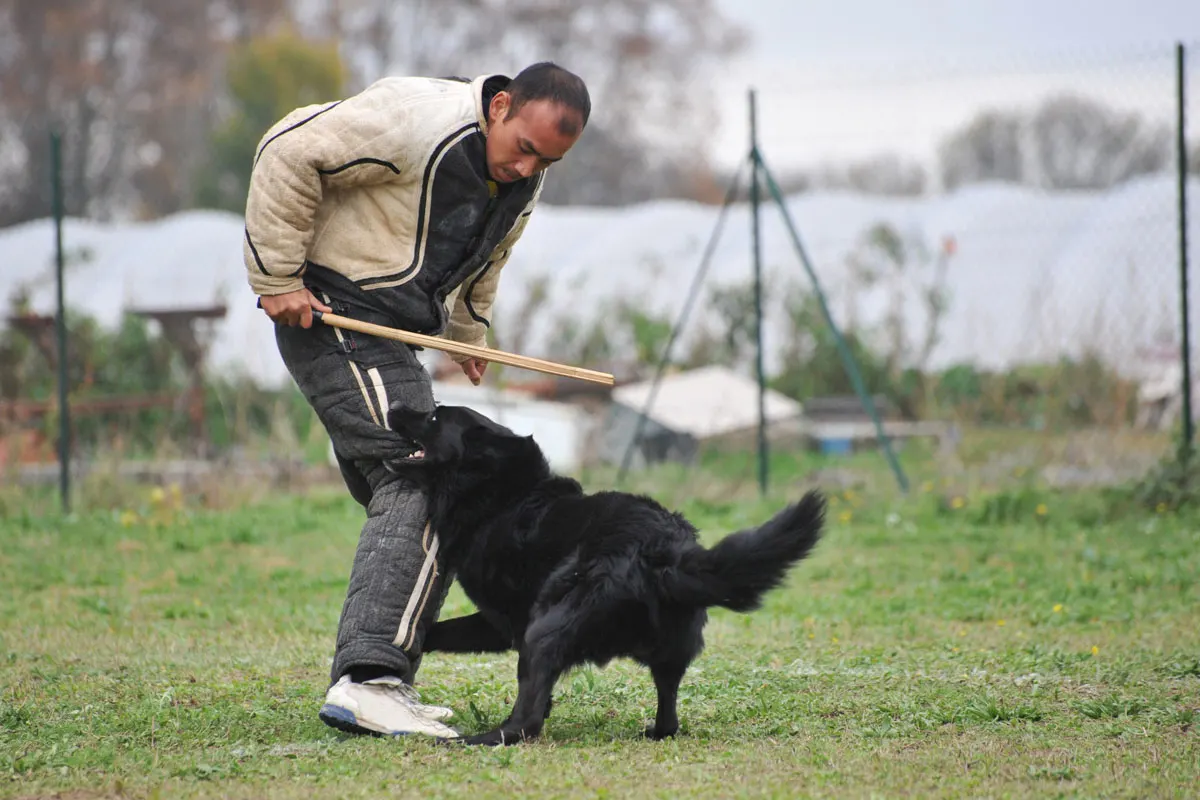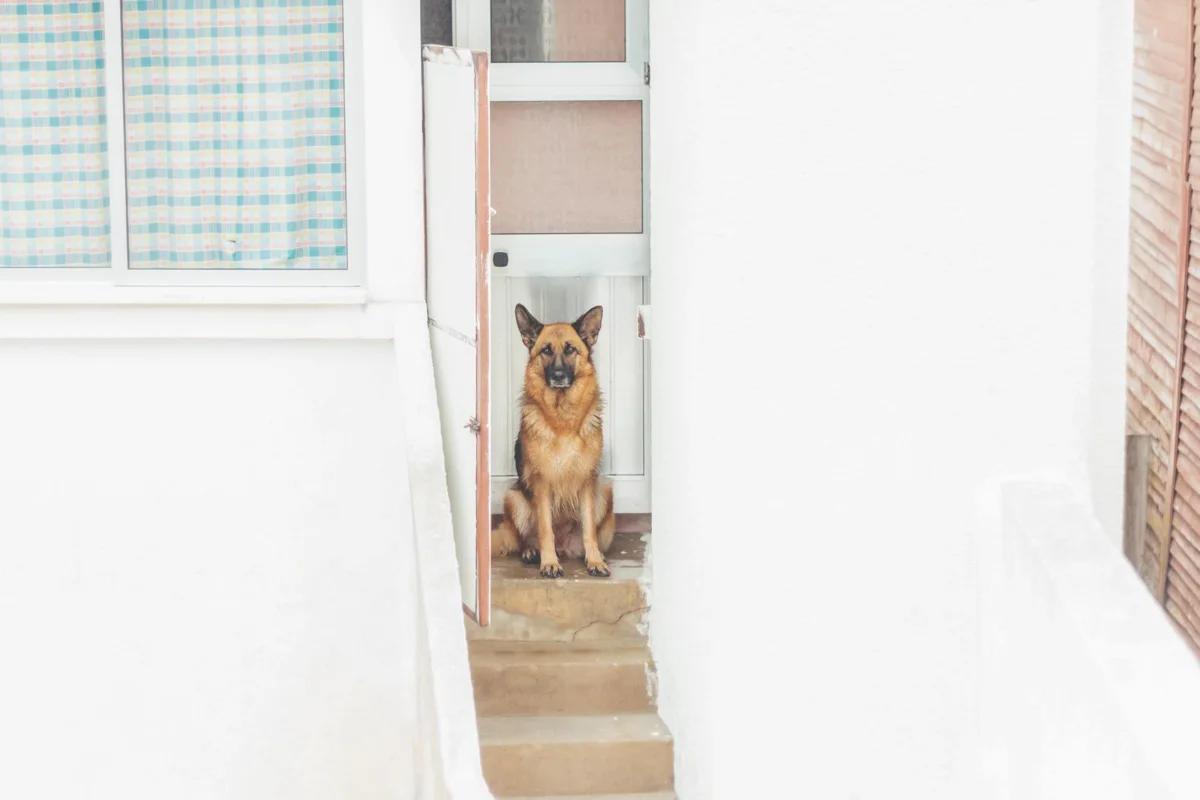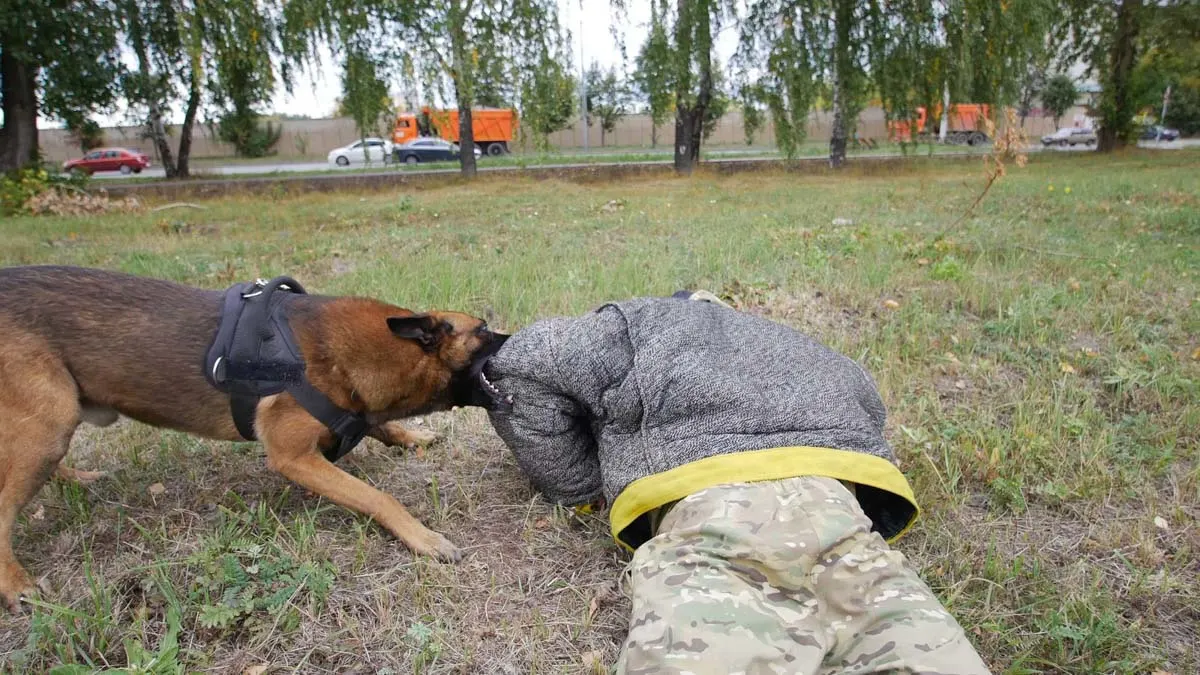Protection dog training is an intricate process that is not for everyone. If your pet does not have the traits to accomplish this training and you try to force it through this process you may irreversibly damage your dog’s psychological well being.
Protection training aims to equip your loyal companion with the skills to safeguard you and your property. Many trainers claim they can teach your dog to have the intelligence and discipline to discern threats and respond accordingly.
In this guide, we’ll explain the art of protection dog training and discuss why it may or may not be for you or your dog.

This guide is not intended as training advice for protection dog training, that should only be undertaken with the personal guidance of a competent and skilled trainer.
Protection dog sports
Protection sports provide an exciting and engaging way for dogs to showcase their natural instincts, intelligence and physical abilities. Some of the more common sports include Schutzhund, KNPV, Mondioring and Belgian Ring.
The common theme amongst all of them is that they combine mental stability, physical obedience and bite work.
Schutzhund
According to the USCA, Schutzhund (German for protection dog) was originally developed specifically for the German Shepherd Dog in the early 1900s, in order to provide breeders with a method for evaluating temperament, character, trainability and mental and physical soundness.
Schutzhund has evolved into a sport where dogs compete in a very demanding exam which is now called “Internationale Gebrauchshund Pruefung,” or IGP. There are three phases which include tracking, obedience, and protection. The tracking phase is intended to test the dog’s trainability and ability to scent, as well as its mental and physical endurance.
The obedience phase includes a series of heeling exercises, some of which are closely in and around a group of people. During the heeling, there is a gun shot test to assure that the dog does not openly react to such sharp noises as well as a retrieval test.
The final phase is protection. The protection phase tests the dog’s courage, physical strength and agility while also challenging the handler’s control of the dog. The exercises include a search of hiding places, finding a hidden person (acting as a decoy) and guarding that decoy.
The dog is to pursue the decoy when an escape is attempted and to hold the grip firmly. The decoy is transported to the judge with the handler and dog walking behind and later at the decoy’s right side.
When the decoy attempts to attack the handler, the dog is expected to stop the attack with a firm grip and no hesitation. The final test of courage occurs when the decoy is asked to come out of a hiding place by the dog’s handler from the opposite end of the trial field.
KNPV
KNPV is short for ‘Koninklijke Nederlandse Politiehond Vereniging’, which is Dutch for Royal Dutch Police Dog Association. According to an article published by Leerburg, the sport was originally designed to provide a certification program by the Dutch government for civilians to train and title dogs that would then be made available to the Dutch Police.
There are several titles in KNPV but the most popular ones are PH1 and PH2. These titles are rigorous and test the dogs’ obedience, nerves and ability to make decisions. One of the tests involve a long send of the dog to a decoy.
When the dog is 30 meters away after reaching speeds of between 32 and 53 miles per hour, the decoy armed with a stick charges the dog and the two impact illustrating a lack of fear in the dog.
Mondioring, French Ring and Belgian Ring
Ring Sports have been taking place in Europe for well over a century. In 1907, the first ring sport was conducted in Mechelen, Belgium. The establishment of separate rules for French and Belgian Ring would flourish from there.
Both French Ring and Belgian Ring involve a dog and handler team that tests a canine’s trainability and courage with three groups of exercises in a program, focusing on obedience, jumping skill and biting work.
Mondioring was created in the late 1980’s by delegates from several countries in Europe and America, in hopes of utilizing different portions of already existing national dog sports, and allowing an enriching union of all the enthusiasts of working dogs, beginners or experienced.

Selecting the right candidate
Selection is key when considering a dog for protection dog training. There are certain traits that if not present may not be trainable. It’s not just about if your dog will bite a human, most dogs are capable of biting a human under certain circumstances such as fear or pain. However, not all dogs are capable of having clarity, confidence and drive while biting a human when commanded too.
Understanding what type of dog you are starting with and how to channel the drives of that dog (prey, fight, defense) is critical. Evaluation by an experienced and competent trainer is crucial. Dogs should also be tested for sociability and suitability for your particular family or security situation.
Certain breeds such as the German Shepherd and Belgian Malinois are more suitable than others based on genetics. An article in Science Daily summarizes “…German shepherds make good guard dogs. While the environment plays a role, traits like these are highly heritable, according to a study of 101 dog breeds. The work identifies 131 genetic variants associated with breed differences in behavior.”
Understanding genetics alone is not enough as each individual dog will have its own personality regardless of its lineage. For example, a dog that is overly timid or fearful despite being of the “right” breed would not be a good candidate to select for this training.
When selecting for suitability think of a scale. You want a balanced dog, not necessarily one that looks or acts the most intimidating. Some of the characteristics to look for in a balanced dog include temperament, drive, trainability and health. It’s just as important to examine the dogs’ oral health as their physical health. See our article on Belgian Malinois bite force to better understand why this is important.
Obedience and control
Basic obedience training is paramount and the foundation for a protection dog, ensuring that they can respond to commands calmly, precisely and reliably. There is no such thing as too much of an obedience foundation.
If your dog struggles to release its toy you can’t expect your dog to release a decoy upon command. I like to focus on control during obedience. You should be able to put your dog in a sit or down and throw their toy without them breaking the command. Then, when you’re ready, release them from the command to hunt for the toy. This shows they have the ability to control themselves under a drive state — the toy is prey to them in this situation.

Bite work
Bite work is something that is usually started as a puppy. It should be something that is done by a highly skilled trainer or breeder who understands drives. Bite work is usually started with a flirt pole or a leather strap which helps train the dog to grip or strongly bite and hold.
To do so, they will need to learn to use the back molars where bite force and grip is strongest. From there it usually progresses to a wedge or bite pillow. The progression from there is eventually to a bite sleeve and a bite suit and then ultimately to a hidden sleeve or muzzle work with no equipment.
All this is done while building the dog up and creating confidence through proper drive channeling. The exact process is too nuanced for a short article such as this and what will work with one dog may not exactly work with another. Once again, you will need to consult a competent trainer if you are unfamiliar with this process.
The decision to train your dog on bite work isn’t one to be taken lightly. It will come with many considerations the least of which may be that your dog will need to be muzzled in specific circumstances in the future.
Discerning threats
After you have established a solid foundation of obedience paired with bite work you can begin to train your protection dog to differentiate between real threats and non-threatening situations, avoiding unnecessary aggression.
For example, a person simply coming up to greet and shake your hand should not elicit an immediate threat response from you dog. You may want to train your dog to activate aggressively towards a person upon command. You can train a preparatory command prior to a bite command so your dog can lock on a particular target.
Everyone’s lifestyle, needs and objectives are different so how and what you train your protection dog to do needs to be tailored to fit that. Ultimately, you will want to train and expose your dog to as many scenarios as you can, the more pictures you paint for your dog the more they should reliably act in situations.
It’s critical to understand that the dog will still need to perceive a situation and act. I do not believe the successful outcome of this process can be guaranteed with 100% accuracy because you are dealing with a living, breathing animal, not a machine or instrument.

Home and family protection
Training a personal protection dog for your family is not necessarily recommended. The dog will have to spend time with a handler or handlers to respect and obey commands. Having your child in control of an animal that can significantly hurt a human may not be the best idea even if it could be safely done.
At the end of the day, it is an animal not a robot and they can make decisions on their own which even the most skilled handler may not be able to mitigate in real time. It’s worth noting that most children don’t understand that their actions may trigger a protection dog.
These dogs are trained to bite humans and may not be able to differentiate between the innocent playing and screaming of a child and genuine aggression. Children love running, screaming and throwing things which could possibly trigger a protection dog’s prey drive.
Liability and legal considerations
It is important to understand the legal responsibilities that come with owning a protection dog, including liability and public safety. You, as the owner, are responsible for anything that dog does regardless of legal consideration. You will have to live with the damage inflicted on a person either intentional or unintentional because of your protection dog.
According to the Insurance Information Institute homeowners insurers paid out $1,136 million in liability claims related to dog bites and other dog-related injuries in 2022. Laws vary from state to state so consult an attorney for detailed information pertaining to protection dog liability.

Conclusion
Protection dogs are best utilized as a deterrent. I believe most criminals would much rather select a home or fight without a dog involved. Protection dog training is a serious undertaking that demands expertise, commitment and a deep understanding of canine behavior.
What most people do not take into consideration is the time commitment not just for the initial training but also for the ongoing maintenance training as well. Understand that you are selecting high drive dogs that need mental and physical exercise to stay healthy.
My best advice for someone interested in protection dog training is to get into protection dog sports first such as PSA, Schutzhund, or Mondioring. Attend local club practice and simply watch. You can then talk to handlers and trainers there to get more of an understanding of what it takes to train a dog to this level.
Ultimately, the decision to pursue protection dog training should be made after careful consideration of the potential risks, ethical concerns, legal responsibilities and the specific needs of the owner and their environment.


Fur-tastic fluffballs: 7 fantastically fluffy dog breeds
Tuesday 7th of November 2023
[…] particularly watchful over children, making them a superb choice for families seeking both a protector and a […]